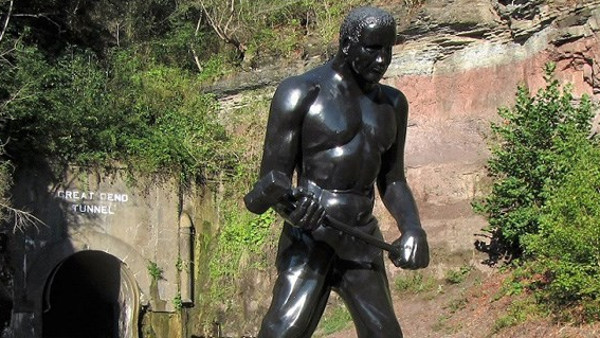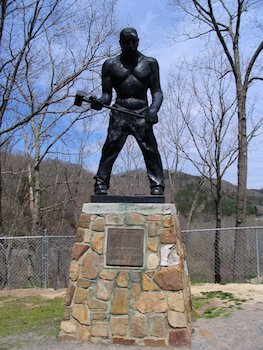SUBJECTS
GRADE
Show Results
John Henry

Lesson Summary
- Sing the folk song “John Henry.”
- Connect to the history of railroads in 19th-century America.
Lesson Plan and Procedure
Lesson Key Facts
- Grade(s): 4, 5, 6
- Subject(s): Music, Social Studies
- Duration of lesson: 45 minutes
- Author(s): Susan Kenney
Vocabulary
Beat, locomotive, John Henry, steel driving, tag, phrase
American History Background
2019 marks the 150th anniversary of the completion of the Transcontinental Railroad. The Union Pacific and Central Pacific Railroads met at Promontory Summit, Utah. The day was May 10, 1869. For the first time, people could travel across the country by train.
Peter Cooper, in 1830, invented the first steam locomotive, the Tom Thumb. His invention influenced the production of railroads across the country. Men worked hard building the railroads, and it was dangerous work. Many African Americans were recruited to build, and one of those was called John Henry. He was a big, powerful man and was proud of his strength. At first, men did all of the work. But as time went by, steam machines were created to do much of the work. The men worried that the machines would take away their jobs. John Henry wanted to prove that he and his hammer could work better than a machine could, so a contest was held. Sure enough, John Henry won, but he used every bit of his strength to beat the machine, and he died in winning. People made up songs about John Henry as they worked every day. We can’t be sure if the story in the song is true or legend. But it is a great story, and it reminds us today how hard people worked to build the railroads that travel across the country, and across every state.
Teaching Ideas
Discuss the fact that 2019 marks the 150th anniversary of the completion of the Transcontinental Railroad and the meeting that took place here in Utah.
Teacher: Have any of you actually ridden in a train, or seen train tracks?
Show a picture of train tracks, and discuss the hard work it takes to lay the rails for thousands of miles.
Teacher: As the people worked on the railroad, they would sometimes get bored and start to sing. They would make up songs as they worked. Sometimes one man would begin to make up a song, and then all the men would echo the last phrase. That is the way the song “John Henry” works. This last repeated phrase in each verse is called a tag.
Teacher: Was John Henry a real person? We can’t be sure, but he probably represented someone who was a very hard worker on the railroad. What do you learn about him from the first verse of the song?
 Sing verse one and then ask for answers. (Possible answers might include that he was a tiny baby, he wanted to be a steel-driving man, and so on.)
Sing verse one and then ask for answers. (Possible answers might include that he was a tiny baby, he wanted to be a steel-driving man, and so on.)
Discuss that a steel-driving man used a large hammer and a bit of steel to break up stone. Invite the learners to listen to the whole story as you sing all of the verses. Invite them to imagine they were there, so they can know what happened to John Henry.
Sing the whole song. Allow the learners to discuss what they learned. (Possible answers might include that he died, he did not want the steam drill to take the place of workers, and so on.)
Sing again and invite learners to echo the last line with you as you sing each verse. Sing again and invite learners to imitate the hammer strokes to the beat and to continue to sing the last line. Invite children to antiphon parts of the song.
Note: Antiphon means to alternate singing musical phrases. This could be done with the teacher singing one phrase, then the students singing the next phrase. It could also be done by having half the class sing a phrase and the other half of the class singing the next phrase, alternating back and forth between the two groups. It does not mean repeating the phrase that was just sung (echoing), but instead, it goes through the entire song, switching who is singing at various places in the song. When antiphoning, the singing doesn’t have to go back and forth every other phrase. The teacher might sing several phrases and then point to the students, and they continue the song until the teacher points back to him- or herself. It might also be a chance for small groups of students to sing small sections of the song, and there might be more than two groups that switch in and out of the singing.
Extensions
- An interesting YouTube video shows illustrations and provides words for everyone to sing along.
- If you watch the video, children may notice that some of the words are different. That is exactly what happens with folk songs. People make up new words. Invite children to create their own verses.
- As you sing it again, invite children to create pictures of each verse and then compile them to make a picture book or PowerPoint presentation of the song.
Learnings for Children to Take Away
- I know a new song.
- I can swing an imaginary hammer in time with the beat as I sing.
- I know the railroad lines met at Promontory Summit in Utah in 1869.
- I can sing a story.
- I can sing alone or with a group.
- I can create lyrics for a song, creating my own song story.
- I can draw pictures of the story (create a book, PowerPoint presentation, and/or slides).
- I know that while working to build the railroad, men sang as they worked and made up songs.
- I know the following words/ideas: phrase, beat, locomotive, John Henry, African-American, tag (repeated last line).
Related Curriculum
- U.S. history (westward expansion—railroad)
- Patterns—math
- Story, vocabulary—literacy
- Drama, creative play
- Visual art, imagination
- Memory practice
Learning Objectives
- Understand how the Transcontinental Railroad influenced the geographic expansion of the United States.
- Investigate the role that African Americans played in building the Transcontinental Railroad.
- Describe the impact of the Industrial Revolution.
- Sing the ballad "John Henry,” a folk song from 19th century America.
- Recognize that music may have a steady beat.
- Explore how music is organized into sections called phrases.
- Understand that a repeated phrase at the end of a song is sometimes called a tag.
Utah State Board of Education Standards
This lesson can be used to meet standards in many grades and subject areas. We will highlight one grade's standards to give an example of application.
Grade 5 Social Studies
Standard 5.4.1: Use evidence from multiple perspectives (for example, pioneers, 49ers, Black Americans, Chinese Americans, Native Americans, new immigrants, people experiencing religious persecution) to make a case for the most significant social, economic, and environmental changes brought about by Westward Expansion and the Industrial Revolution.
Standard 5.4.2: Use primary sources to explain the driving forces for why people immigrated and emigrated during the 19th century, as well as the ways that movement changed the nation.
Grade 5 Music
Standard 5.M.P.4: Sing folk, traditional, and rounds in tune, with good vocal tone and clear diction.
Standard 5.M.R.2: Listen for and identify form, meter, rhythm, timbre, mood, tempo, melody, texture, and harmony/tonality.
Standard 5.M.CO.4: Experience and explore music which connects us to history, culture, heritage, and community.
Equipment and Materials Needed
- YouTube video: “The Ballad of John Henry” (optional)
- Images of the building of the railroad
- Slides 14-24 in PowerPoint: “Folk Songs from U.S. History”
- “John Henry” sheet music and chord chart
Additional Resources
- Additional information about railroad workers from the 1800s can be found in the lesson plan “Railroad Meter” on the BYU Arts Partnership website.
- https://en.wikipedia.org/wiki/John_Henry_(folklore)
Image References
Image 1: https://www.nps.gov/neri/planyourvisit/the-legend-of-john-henry-talcott-wv.htm.
Image 2: Theclio (https://www.theclio.com/web/entry?id=466).

www.education.byu.edu/arts/lessons
 Download
Download